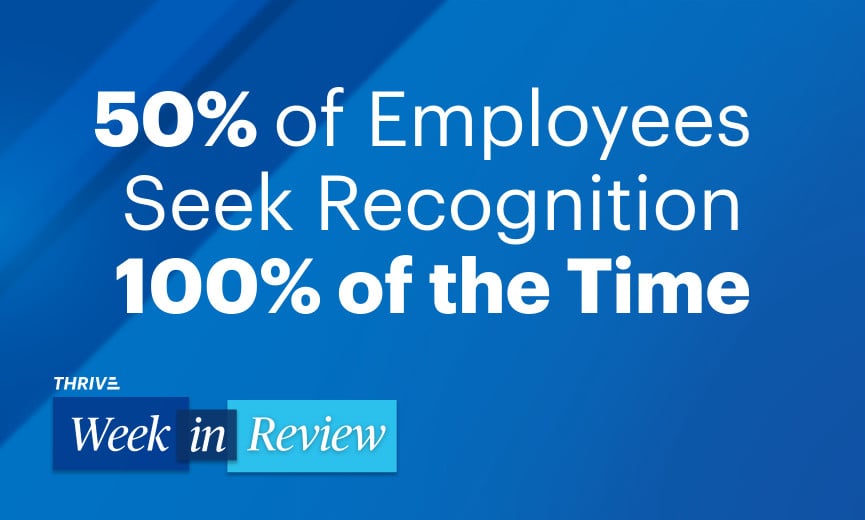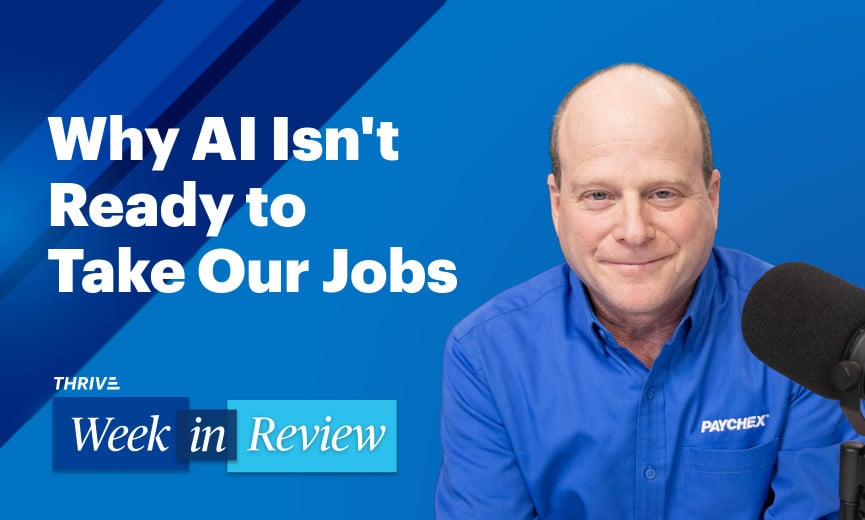- Thrive
-
Season
5Episode44
Small Business Growth, Economic Rebound, AI Advantage, Business Buying and Selling
Podcast •
Watch
Summary
Join host Gene Marks in this week's episode of the Paychex Thrive Week in Review, where we delve into the latest developments that could impact your small business. From employment rates to economic sentiment and business transactions, Gene covers it all.
Small business job growth continues to remain stable in July, with wages holding at a consistent rate. "Our latest employment data points to a small business labor market that has remained consistent," notes Paychex CEO John Gibson.
AI adoption is also on the rise, with nearly 40% of small businesses using it, many noting positive impacts.
Gene also discusses rising economic optimism, with 46% of small business owners feeling positive about the economy, up from just 30% last quarter.
Tune in as Gene unpacks the data and explores what these trends mean for your business.
View Transcript
Hey everybody, it's Gene Marks. And welcome to this week's episode of the Paychex THRIVE Week in Review. This is where we take a few items from the news during the past week that impacts your small business and mine, and we talk a little bit about it. So two items of good news, one items of not so good news. Let's turn to the good news first, and that comes from Paychex.
Paychex released their July Small Business Employment Watch report and it continued to show sustainability for small businesses. Job growth among U.S. small businesses with fewer than 50 employees is holding steady, according to the Paychex Small Business Employment Watch for July. The national Small Business Jobs Index, a primary component of the report that measures the pace of small business jobs across the country, has increased just a slight, slight amount to a level 99.82 in July. Meanwhile, hourly earnings growth for small business workers has maintained a consistent trend, remaining below 3% for the ninth consecutive month, according to John Gibson, Paychex CEO and President. Our latest employment data points to a small business labor market that has remained consistent, including wages continuing below 3%, while workers have begun to see an increase in hours worked in July for the first the first time since August 2024.
We entered the back half of 2025 in a very similar position that we as we started, which speaks to the resiliency of small businesses given the amount of uncertainty they faced so far this year. So far in amidst all the uncertainty, tariffs, inflation, high interest rates, all that small business job growth remains stable, small business employment remained resilient. That is good news. The second item of news comes from a new survey that came out. It's a quarterly survey from CNBC and SurveyMonkey.
It's called their Small Business Confidence Index. And let me read to you what happened here. Optimism about the fate of the economy rebounded among small businesses after a sharp decline in the second quarter, with nearly half of small business owners 46% since saying that the economy is excellent or good. That's up from 30% in just the last quarter. Fewer small business owners have been or expected to be impacted by tariffs, and slightly more than half are concerned about the impact of tariffs on their businesses, which is down from 59% in the second quarter.
Nearly 4 in 10 small business owners use AI to help run or operate their businesses. Three quarters of small business owners, 75% who use AI in their business report a positive impact on their business. And more than half of small business owners say AI is already or may reduce employee headcount. 1 in 5 say AI has already reduced employee headcount. So according to the latest quarterly server from CNBC and Survey Monkey, small businesses, their optimism has gone up significantly this past quarter after a sharp decline in the last quarter, which again indicates resilience among these business owners. And that is good news.
The third bit of news is not as good. This comes from BizBuySell, which is a research and marketplace for companies looking to buy and sell, well, each other. Every quarter they put out their Insight report and actually they found that business transactions, those are the level of businesses that have either bought or sold in this quarter. They've actually fallen 4% year over year and 1% quarter over quarter. Median sales prices among businesses have dropped as buyers shift to lower price deals.
So what's going on? Well, a total of about 2,300 businesses in their database change hands in the second quarter of 2025, down 4% from the same period when there was easy inflation and stronger than expected 2.8% GDP growth last period that heightened buyer confidence. The momentum continued until the Trump administration's sweeping tariff announcements triggered uncertainty and slowed down deal activity. Transactions are now just 1% lower than they were last quarter as the market continues to adjust, according to one analyst, a guy named Dustin Zeher, who's also a business broker. He said the uncertainty around how tariffs will impact businesses that rely on imported products are and how that affects the financial performance is causing buyers to hesitate.
So sales and transactions of businesses are actually down 4% year over year. So that's the news to report for this week for businesses that impact news that impacts your business and mine. You have been watching the Paychex THRIVE Week in Review. My name is Gene Marks. If you need any help or advice or tips in running your business, please Visit us at paychex.com/thrive and sign up for our newsletter.
And that way you can get the most recent episodes of this podcast as well as some help in running your business. Hope you find this information helpful. We will see you again next week with more news that impacts your business and a few words on how it impacts your business. Take care.
This podcast is Property of Paychex Incorporated 2025.
All rights reserved.

 Apple Podcast
Apple Podcast Spotify
Spotify iHeartRadio
iHeartRadio









